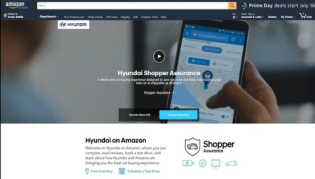Latest News From Bumper to Bumper Radio

More Robust Information on the Hyundai Brand and Vehicles is Available on Amazon.com
Ability for Customers to Quickly Find a Hyundai Dealer in their Area and Enjoy Easy Access to all Hyundai Shopper Assurance Conveniences
Fountain Valley, Calif., July 18, 2018 - Hyundai continues to deliver on its commitment to exceptional customer service with a new digital showroom on Amazon.com that offers car buyers the ability to compare pricing and reviews, book test drives, check dealer inventories and other Shopper Assurance conveniences directly through Amazon Vehicles. The new digital showroom can be found at Amazon.com/Hyundai.
"The car industry is changing, and customer demands and expectations around a frictionless, efficient and transparent experience are key drivers," said Dean Evans, CMO, Hyundai Motor America. "Hyundai Shopper Assurance was just the first step in modernizing the way people shop for and buy cars. We are excited to continue improving the automotive retail experience by offering tools and access that make shopping for a car even easier."
"This collaboration with Amazon provides customers with the ability to learn about Hyundai vehicles in a way that matches their expectations for nearly every other type of purchase," said Tim Maxwell, senior group manager, digital marketing, Hyundai Motor America. "Hyundai and its dealers are modernizing the car buying process, so it made sense for us to be the first car company with its own digital showroom."
The latest automotive industry research shows that 12% of consumers still have a dead or unusable vehicle battery at home and not in the closed recycling loop. In an effort to bring those remaining vehicle batteries that sit in forgotten corners of garages or in inoperative vehicles back into the recycling loop, the Responsible Battery Coalition has launched the 2 Million Battery Challenge.
Recycling your used vehicle battery is quick and easy. Just drop it off at a local retailer. To find a location near you, visit https://www.responsiblebatterycoalition.org/

On the week, the national gas price average is two cents cheaper at $2.90. Today’s national average is only one cent more expensive than a month ago, but 60 cents more expensive than a year ago.
Nationwide, 44 states have less expensive or steady gas price averages compared to last Monday. However, the cheaper trend may be reversing. Gasoline demand spiked in the latest Energy Information Administration’s (EIA) report, in fact setting a new all-time record at 9.88 million b/d for the week ending June 8. As demand skyrockets, U.S. gasoline inventories plummeted 2.27 million bbl, to land total inventories at 237 million bbl, which is 5.7 million below stocks last year at this time.
“If demand continues to strengthen and inventories decrease in the weeks ahead, motorists can expect gas prices do a reversal and start to increase again,” said Jeanette Casselano, AAA gas price expert. “AAA expects the national gas price average to range between $2.85 and $3.05 through Labor Day, likely seeing the summer’s highest prices in June.”
Moving into this week, another factor that will influence gas prices in the near and long-term will be outcomes from the June 22 OPEC meeting in Vienna, Austria. The cartel, along with other major producers including Russia, will discuss increasing oil production ahead of the year-end scheduled dissolution of its production reduction agreement. Some reports indicate that OPEC could be looking at an increase of 300,000 to 600,000 b/d to help ease global crude price gains that have grown since the cartel put its production reduction agreement into place at the beginning of 2017. An increase in production would likely decrease crude oil prices and encourage cheaper gas prices.
Quick Stats
The nation’s top 10 most expensive markets are: Hawaii ($3.73), California ($3.71), Washington ($3.45), Alaska ($3.43), Oregon ($3.32), Nevada ($3.31), Utah ($3.19), Idaho ($3.19), Connecticut ($3.11) and Arizona ($3.07).
The nation’s top 10 largest weekly changes are: Ohio (-10 cents), Florida (-5 cents), Delaware (-5 cents), Indiana (+5 cents), Virginia (-5 cents), Utah (+4 cents), Maryland (-4 cents), Iowa (-4 cents), Kansas (-4 cents) and Illinois (-4 cents).
Lauren Fix joins Boom Bust to talk about Tesla and other Auto Industry news. Here is the inside scoop on Elon Musk's trip to China and future plans to build a factory in China.

The national gas price average is $2.87, which is a penny more expensive on the week. Pump prices in nearly 30 states are seeing a jump of as much as eight cents, a dozen states saw prices drop and another dozen states’ gas price averages remain stable from last Monday.
“Demand for gasoline this summer remains very strong week-over-week, driving gas prices higher alongside rising crude prices,” said Jeanette Casselano, AAA spokesperson. “Today motorists are seeing gas for $2.76 or more at 56 percent of gas stations across the country.”
Today’s gas price average is six-cents cheaper than last month, but 61-cents more expensive than at the same time last year.
Quick Stats
The nation’s top 10 largest weekly changes are: Delaware (+8 cents), Michigan (-7 cents), Ohio (+6 cents), Indiana (+5 cents), Maryland (+4 cents), New Mexico (-3 cents), Pennsylvania (+3 cents), Georgia (+3 cents), Kentucky (+3 cents) and Oklahoma (+3 cents).
The nation’s top 10 least expensive markets are: South Carolina ($2.53), Alabama ($2.53), Mississippi ($2.55), Louisiana ($2.58), Arkansas ($2.60), Missouri ($2.61), Tennessee ($2.61), Oklahoma ($2.62), Virginia ($2.62) and Kansas ($2.66).
West Coast
Pump prices in the West Coast region are among the most expensive in the country: Hawaii ($3.73), California ($3.66), Washington ($3.44), Alaska ($3.40), Oregon (3.32), Nevada ($3.24) and Arizona ($3.00). Most prices in the region have declined on the week, with Arizona (-2 cents) leading the group.
Inventories of gasoline in the region fell for a third consecutive week, according to the Energy Information Administration’s (EIA) petroleum status report for the week ending on June 29. Dropping by nearly 150,000 bbl, total inventories now sit at 30.5 million bbl. However, inventories are approximately 2.2 million bbl higher than they were at this point last summer, which will likely help prices stabilize if there are any major supply disruptions in the region this week.


















